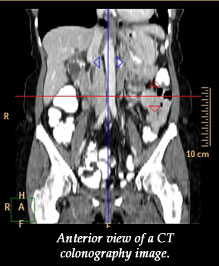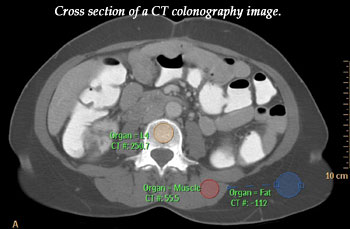Inside Science News Service
December 10, 2008
One Test for Two Diseases
Research Shows that CT Colonography Can Screen for Osteoporosis as well as Cancer
By Jason Socrates Bardi
ISNS Contributor
Chicago, IL - A common test for colorectal cancer may also allow doctors to screen patients for osteoporosis, a low bone mass problem that afflicts millions of Americans, medical researchers from the University of California, San Francisco, announced last week at the annual meeting of the Radiological Society of North America.  The research looked at the technique of CT colonography which takes images with X-rays to provide cross-sectional snapshots of various parts of the body.
The research looked at the technique of CT colonography which takes images with X-rays to provide cross-sectional snapshots of various parts of the body.
CT colonography is an important screen for colorectal cancer, the third most common form of cancer in the United States and the second leading cause of cancer death. Rizwan Aslam, an assistant clinical professor of radiology at UCSF, and his colleagues evaluated 35 people who underwent CT colonography at the San Francisco Veterans Administration Hospital.
They wanted to see if in scanning the abdomens of these 35 people, CT colonography would also collect data on the condition of their spine. They hypothesized that this spine data would allow them to measure bone mineral density - an indicator of risk for osteoporosis or "porous bone," a disease in which bones become fragile and prone to fracture. According to the National Institutes of Health, some 10 million Americans already have osteoporosis and 34 million more have low bone mass and are at increased risk for the disease.
"If we pick it up early, potentially we can prevent [the osteoporosis] or treat it at an early stage," says Aslam. "Early diagnosis is essential."
 Aslam and his colleagues discovered that CT colonography can indeed evaluate people for osteoporosis. The study showed excellent agreement between the CT estimates of bone density and estimates derived from dual-energy X-ray absorptiometry (DEXA), the current clinical standard bone density screening tool.
Aslam and his colleagues discovered that CT colonography can indeed evaluate people for osteoporosis. The study showed excellent agreement between the CT estimates of bone density and estimates derived from dual-energy X-ray absorptiometry (DEXA), the current clinical standard bone density screening tool.
Both tests identified osteoporotic bones, says Aslam, adding that CT colonography should not be regarded as a replacement for DEXA but as added value for colorectal cancer screening, helping to identify risk for two separate diseases in one test.
"This is a very interesting finding," says Maryellen Giger, a professor of radiology and chair of the Committee on Medical Physics at The University of Chicago who was not involved with the study. "It is not surprising that one can extract information on bone density from a CT scan, and this study indicates that this data may be able to identify those at risk for osteoporosis, who would then potentially follow up with low-dose [radiation-based] screening methods for osteoporosis such as DEXA."
This story is provided for media use by the Inside Science News Service, which is supported by the American Institute of Physics, a not-for-profit publisher of scientific journals. Please credit ISNS. Contact: Jim Dawson, news editor, at jdawson@aip.org.





















